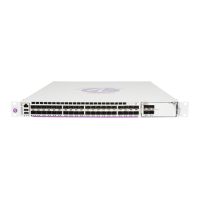Introduction to Services on the 7705 SAR
Page 36 7705 SAR OS Services Guide
Introduction to Services on the 7705 SAR
A service is a type of telecommunications connection from one place to another. These
telecommunications connections have the particular attributes and characteristics that are
needed to provide a specific communications link through which an information flow or
exchange can occur. The 7705 Service Access Router (7705 SAR) offers Layer 2 point-to-
point VPN services, Layer 3 MPLS VPN services (VPRN), and Layer 3 routed/IP services.
The 7705 SAR service model uses (logical) service entities to construct a service. These
logical entities provide a uniform, service-centric configuration, management, and billing
model for service provisioning (see Alcatel-Lucent Service Model on page 40 for more
information). Many services can be created on the same 7705 SAR at the same time, and
each service is uniquely identified by a service ID.
The 7705 SAR offers Virtual Leased Line (VLL) services (also referred to as pseudowire
(PW) services or pipes), which emulate a Layer 1/2 entity, such as a wire or a leased line.
These emulated services provide connectivity between a service access point (SAP) on one
7705 SAR and on another SAP on the same router, or on a remote 7705 SAR, 7710 SR,
or 7750 SR. VLL services offer SAP logical entities – such as a VLAN or a virtual
connection – Layer 2 visibility or processing (IMA termination). A SAP is the point where
customer traffic enters and exits the service.
When the connection is between two SAPs on the same router, this is known as local
service. When the connection is between SAPs on a local and a remote router, this is known
as distributed service. SAP-to-SAP connections are supported for ATM, Ethernet, and TDM
VLLs.
Distributed services use service destination points (SDPs) to direct traffic from a local router
to a remote router through a service tunnel. An SDP is created on the local router and
identifies the endpoint of a logical unidirectional service tunnel. Traffic enters the tunnel at
the SDP on the local router and exits the tunnel at the remote router. Hence, a service tunnel
provides a path from a 7705 SAR to another service router, such as another 7705 SAR, a
7710 SR, or a 7750 SR. Because an SDP is unidirectional, two service tunnels are needed for
bidirectional communication between two service routers (one SDP on each router).
SDPs are configured on each participating 7705 SAR or service router, specifying the
address of the source router (the 7705 SAR participating in the service communication) and
the address of the destination router, such as another 7705 SAR or service router. After
SDPs are created, they are bound to a specific service. The binding process is needed to
associate the far-end devices to the service; otherwise, far-end devices are not able to
participate in the service.
The 7705 SAR also offers IES and VPRN services.

